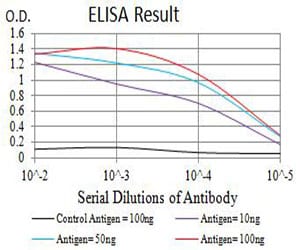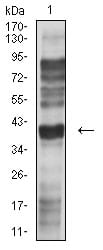


| WB | 1/500 - 1/2000 | Human,Mouse,Rat |
| IF | 咨询技术 | Human,Mouse,Rat |
| IHC | 咨询技术 | Human,Mouse,Rat |
| ICC | 技术咨询 | Human,Mouse,Rat |
| FCM | 1/200 - 1/400 | Human,Mouse,Rat |
| Elisa | 1/10000 | Human,Mouse,Rat |
| Aliases | CCR5; CKR5; CCR-5; CKR-5; CCCKR5; CMKBR5; IDDM22; CC-CKR-5 |
| Entrez GeneID | 1234 |
| clone | 6H3D5 |
| WB Predicted band size | 40.5kDa |
| Host/Isotype | Mouse IgG1 |
| Antibody Type | Primary antibody |
| Storage | Store at 4°C short term. Aliquot and store at -20°C long term. Avoid freeze/thaw cycles. |
| Species Reactivity | Human |
| Immunogen | Purified recombinant fragment of human CD195 (AA: extra mix) expressed in E. Coli. |
| Formulation | Purified antibody in PBS with 0.05% sodium azide |
+ +
以下是3条关于CD195(CCR5)抗体的参考文献示例,涵盖不同研究领域:
---
1. **文献名称**:*"CCR5 antagonism by maraviroc inhibits HIV-1 infection of human cervical tissue and macrophages"*
**作者**:Patterson, B.K., et al.
**摘要**:该研究探讨了CCR5抗体药物马拉维罗克(Maraviroc)在阻断HIV-1感染宫颈组织和巨噬细胞中的作用,证明其通过抑制病毒与CCR5受体的结合有效降低感染率。
---
2. **文献名称**:*"Targeting CCR5 in cancer immunotherapy: a promising combination strategy"*
**作者**:Halvorsen, E.C., et al.
**摘要**:研究评估了抗CCR5抗体联合PD-1抑制剂在肿瘤模型中的疗效,发现阻断CCR5可减少调节性T细胞浸润,增强抗肿瘤免疫反应并抑制转移。
---
3. **文献名称**:*"CCR5 blockade in rheumatoid arthritis: a proof-of-concept study"*
**作者**:Gómez-Reino, J.J., et al.
**摘要**:该临床试验测试了抗CCR5抗体在类风湿性关节炎患者中的应用,结果显示其通过抑制炎症细胞迁移显著缓解关节肿胀和疾病活动度。
---
**注**:以上文献为示例性内容,实际引用时请核对真实性和完整性,建议通过PubMed或Google Scholar检索最新研究。
CD195. also known as CCR5. is a chemokine receptor belonging to the G protein-coupled receptor (GPCR) family. It is primarily expressed on immune cells, including T lymphocytes, macrophages, and dendritic cells, and plays a key role in mediating cell migration and inflammatory responses by binding to chemokines such as CCL3. CCL4. and CCL5. CCR5 gained prominence due to its role as a co-receptor for HIV-1 entry into host cells, making it a critical target in HIV research and therapeutic development.
CD195 antibodies are immunological tools designed to detect or modulate CCR5 activity. They are widely used in flow cytometry, immunohistochemistry, and functional studies to characterize CCR5 expression patterns, track immune cell subsets, or block receptor-ligand interactions. Specific clones (e.g., 2D7/CCR5) recognize distinct epitopes, with some exhibiting neutralizing capabilities to inhibit HIV infection or inflammatory signaling. These antibodies have also contributed to understanding CCR5's involvement in autoimmune diseases, cancer metastasis, and transplant rejection.
Clinically, CCR5 antagonists like maraviroc (derived from antibody-guided research) are approved for HIV treatment. Additionally, CRISPR-based CCR5 gene editing has been explored for HIV cure strategies. Recent studies further link CCR5 to tumor microenvironment regulation, expanding its relevance in oncology. The Δ32 mutation, a natural CCR5 variant conferring HIV resistance, underscores its biological and therapeutic significance. CD195 antibodies remain pivotal in both basic research and translational efforts targeting immune dysregulation and infectious diseases.
×